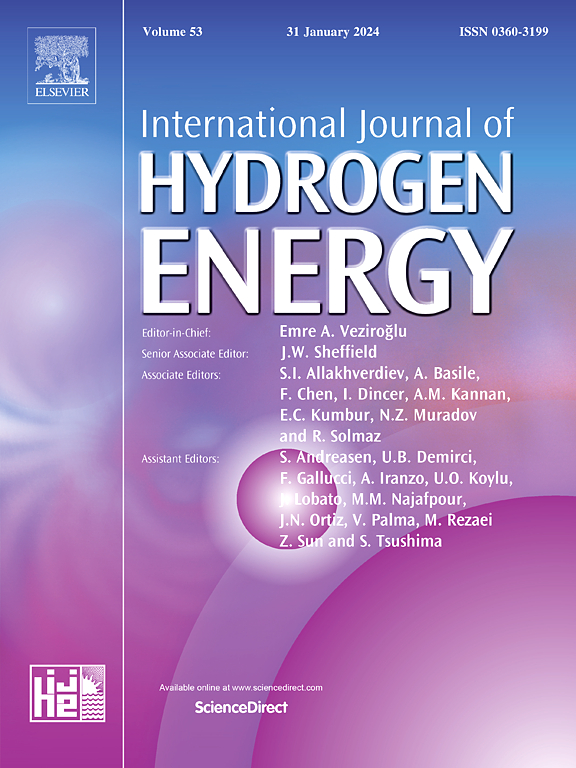Photoelectrochemical hydrogen generation using gradient-bandgap semiconductor arrays for improved solar energy conversion and water splitting efficiency
IF 8.3
2区 工程技术
Q1 CHEMISTRY, PHYSICAL
引用次数: 0
Abstract
Photoelectrochemical (PEC) water splitting offers a promising route for solar hydrogen production, but current systems suffer from limited light absorption, poor charge separation, and inadequate stability. This study aimed to develop a novel gradient-bandgap semiconductor array architecture to overcome these fundamental limitations and enhance solar-to-hydrogen (STH) conversion efficiency. Gradient-bandgap semiconductor arrays were fabricated via atomic layer deposition, creating sequential layers of TiO2, WO3, and BiVO4 with compositionally graded interfaces. XRD, HRTEM, XPS, and UV–vis spectroscopy provided photoelectrode characterization. Under simulated AM 1.5G illumination, the photoelectrochemical capabilities were assessed via intensity-modulated photocurrent spectroscopy, electrochemical impedance spectroscopy, incident photon-to-current efficiency, and current-voltage measurements. The gradient-bandgap architecture attained a STH conversion efficiency of 12.32 %, representing a 7.1-fold improvement over single-material BiVO4 photoelectrodes (1.73 %). Photocurrent density reached 16.78 mA/cm2 at 1.23 V versus reversible hydrogen electrode, with a corresponding hydrogen evolution rate of 6.21 mmol/h·cm2. The photoelectrode demonstrated exceptional stability, retaining 95.1 % of its initial performance after 200 h of continuous operation. Charge transfer efficiency reached 90.4 %, significantly higher than the 59.2–75.8 % observed in single-material electrodes, while carrier lifetime extended to 18.3 ns (39–115 % improvement over individual components). The gradient-bandgap semiconductor array design successfully addresses the critical limitations of conventional photoelectrodes through synergistic integration of complementary materials with engineered interfaces. This approach provides a practical pathway toward high-efficiency, durable, and economically viable solar hydrogen production without requiring expensive noble metal catalysts.
利用梯度带隙半导体阵列提高太阳能转换和水分解效率的光电化学制氢技术
光电化学(PEC)水分解为太阳能制氢提供了一条很有前途的途径,但目前的系统存在光吸收有限、电荷分离差和稳定性不足的问题。本研究旨在开发一种新的梯度带隙半导体阵列架构,以克服这些基本限制并提高太阳能到氢(STH)的转换效率。通过原子层沉积制备了梯度带隙半导体阵列,形成了具有组成梯度界面的TiO2, WO3和BiVO4的顺序层。XRD, HRTEM, XPS和UV-vis光谱进行了光电极表征。在模拟AM 1.5G照明下,通过强度调制光电流谱、电化学阻抗谱、入射光子-电流效率和电流-电压测量来评估光电化学性能。梯度带隙结构获得了12.32%的STH转换效率,比单材料BiVO4光电极(1.73%)提高了7.1倍。与可逆氢电极相比,在1.23 V下光电流密度达到16.78 mA/cm2,相应的析氢速率为6.21 mmol/h·cm2。该光电极表现出优异的稳定性,在连续工作200小时后仍保持其初始性能的95.1%。电荷转移效率达到90.4%,显著高于单材料电极59.2 - 75.8%,载流子寿命延长至18.3 ns(比单材料电极提高39 - 115%)。梯度带隙半导体阵列设计成功地解决了传统光电极的关键局限性,通过互补材料与工程界面的协同集成。这种方法为实现高效、耐用、经济可行的太阳能制氢提供了一条可行的途径,而不需要昂贵的贵金属催化剂。
本文章由计算机程序翻译,如有差异,请以英文原文为准。
求助全文
约1分钟内获得全文
求助全文
来源期刊

International Journal of Hydrogen Energy
工程技术-环境科学
CiteScore
13.50
自引率
25.00%
发文量
3502
审稿时长
60 days
期刊介绍:
The objective of the International Journal of Hydrogen Energy is to facilitate the exchange of new ideas, technological advancements, and research findings in the field of Hydrogen Energy among scientists and engineers worldwide. This journal showcases original research, both analytical and experimental, covering various aspects of Hydrogen Energy. These include production, storage, transmission, utilization, enabling technologies, environmental impact, economic considerations, and global perspectives on hydrogen and its carriers such as NH3, CH4, alcohols, etc.
The utilization aspect encompasses various methods such as thermochemical (combustion), photochemical, electrochemical (fuel cells), and nuclear conversion of hydrogen, hydrogen isotopes, and hydrogen carriers into thermal, mechanical, and electrical energies. The applications of these energies can be found in transportation (including aerospace), industrial, commercial, and residential sectors.
 求助内容:
求助内容: 应助结果提醒方式:
应助结果提醒方式:


